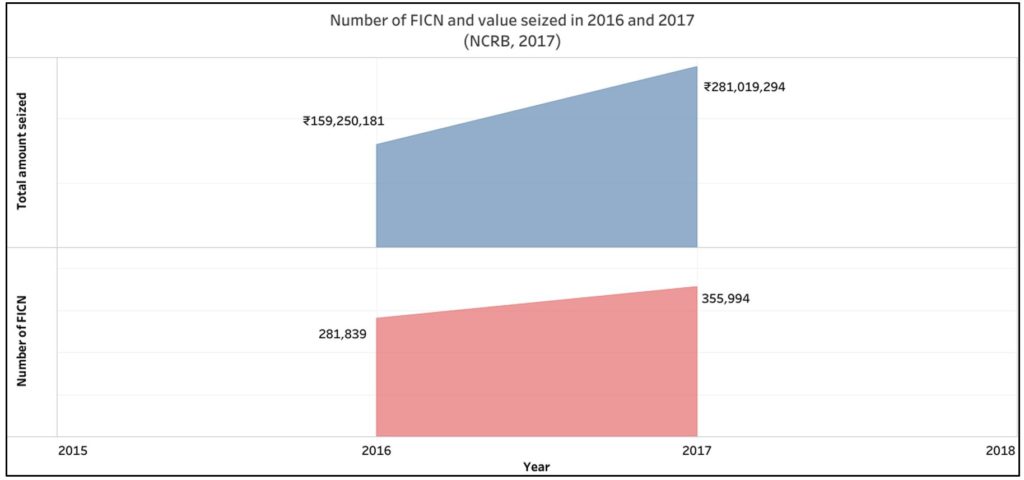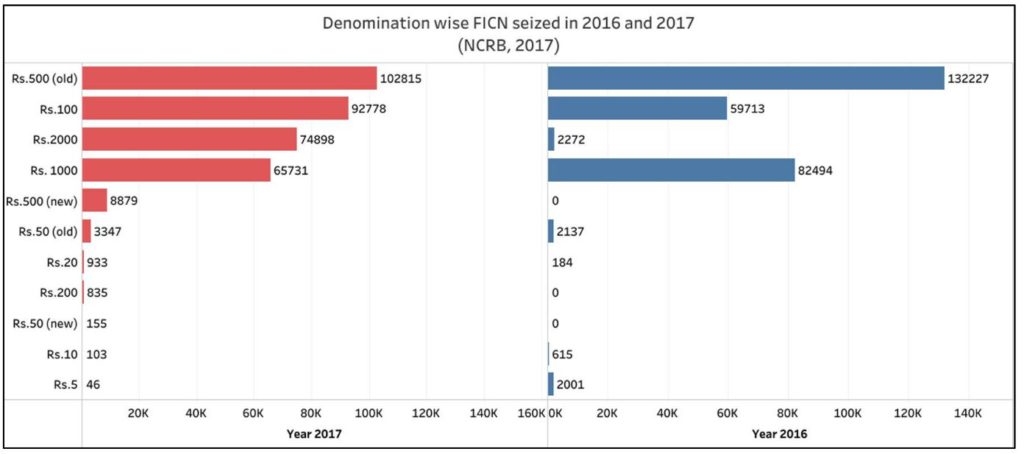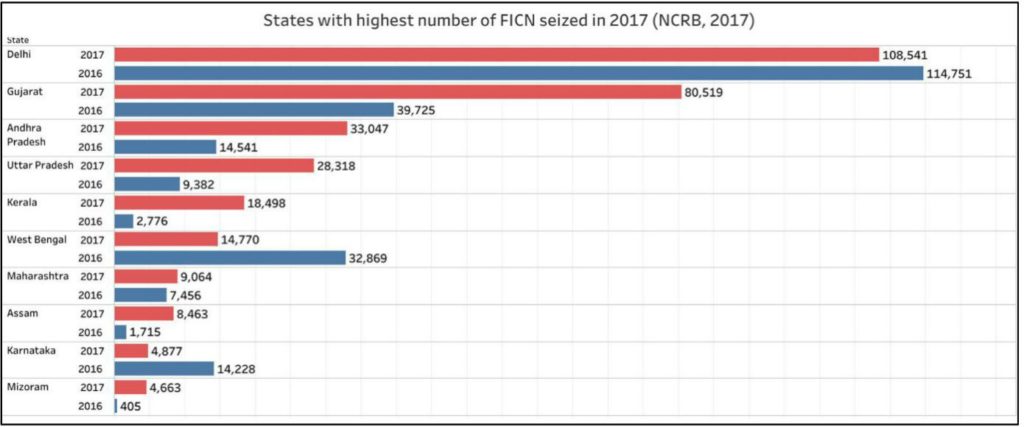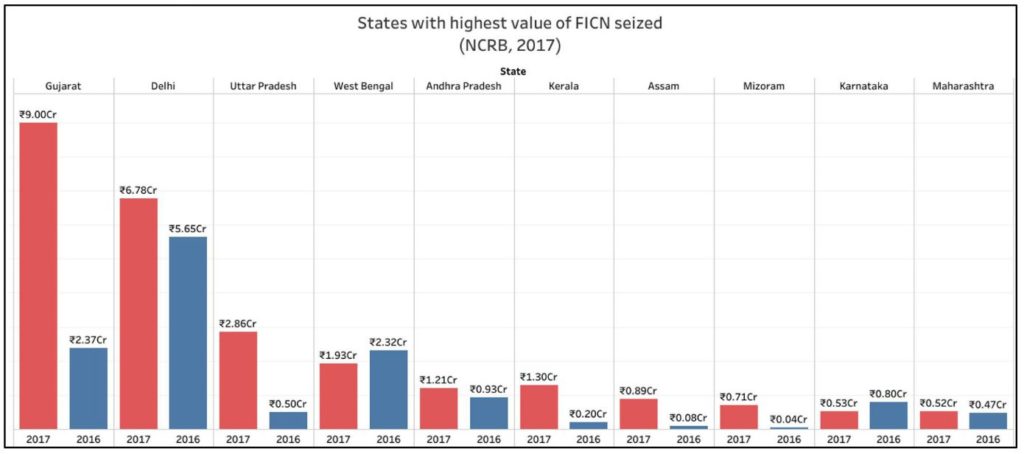[orc]The NCRB’s Crime in India report provides data on the Fake currency notes seized by various law enforcement agencies. As per data of the 2017 report, the value of fake currency seized across the country has increased by more than 70% in 2017. Gujarat & Delhi still account for more than 50% of the fake currency seized in the country.
There seems to be no end to the debate over whether or not fake currency circulation has decreased post-demonetisation. While a definitive answer is difficult, the data from various sources like the RBI & NCRB could give us some insights.
The National Crime Records Bureau (NCRB) compiles data on the number of ‘Fake Indian Currency Notes’ (FICN) seized every year in its annual Crime in India report.
The Crime in India report of 2017, released recently is the first publication of the bureau which covers one full year’s fake currency-related details after the ₹ 500 and ₹ 1000 notes were demonetized in 2016.
The figures presented in 2016 have already been analysed by Factly in an earlier story. This story focusses on the 2017 figures and comparison with 2016 data.
Counterfeiting currency notes is criminalised under Section 489 of IPC
Counterfeiting currency notes is a crime under Section 489 of the Indian Penal Code. Possession, production and usage of counterfeit notes can result in severe punishment up to life term imprisonment along with a hefty fine.
Face value of fake notes has increased by 76.4% since demonetisation
In 2017 alone, fake currency worth ₹ 28.1 crores were seized. In other words, an average of 975 fake notes worth ₹ 7.69 lakhs were confiscated per day in 2017. On the other hand, the value of fake currency seized in 2016 was ₹ 15.9 crores. Thus, the value of fake currency seized in 2017 is 76.4% more than the value of FICN seized in 2016. NCRB included fake currency seizure-related data in its report only since 2016.

₹ 2000, ₹ 1000 & ₹ 500 notes together account for 95% seized FICN
Fake ₹ 2000 notes with a face value of ₹ 14.9 crores were seized in 2017, constituting 53% of the FICN seized in 2017. FICN of ₹ 1000 accounted for 23% of the total amount or ₹ 6.57 crores. It has to be noted that ₹ 1000 notes are no longer considered legal tender. Fake notes of the old ₹ 500 denomination, worth ₹ 5.14 crores were also seized in 2017. All these notes together were worth ₹ 26.69 crores and accounted for 95% of the total value of FICN seized in 2017.

Number of fake 2000 notes increased substantially
The maximum number of counterfeit notes seized in 2017 were that of the old ₹ 500 notes followed by ₹ 100 notes. However, the number of fake ₹ 500 notes (old & new) came down by 28.6% while number of fake ₹ 100 notes increased by 55% compared to 2016. There was also a substantial increase in the number of fake ₹ 2000 notes seized in 2017, when close to 75000 such notes were seized. Since they were introduced only in November 2016, the real impact of the fake notes was seen in 2017.
Delhi and Gujarat accounted for maximum number of fake ₹ 1000 & ₹ 2000 notes
In terms of number of notes, a total of 3,55,994 notes were seized in 2017 of which counterfeits of old ₹ 500 notes were more than a lakh. Gujarat accounted for the maximum number of fake ₹ 2000 notes seized. A total of 41% of the fake ₹ 2000 notes were seized in Gujarat. Delhi accounted for 61% of the fake old ₹ 1000 rupees notes seized.

Gujarat and Delhi account for 53% of the volume & 56% of the total face value of fake notes seized
The maximum number of fake currency notes were seized in Gujarat. A total of 80,519 notes summing up to ₹ 9 crores were seized in Gujarat. In Delhi, 1 lakh notes worth ₹ 6.78 crores were seized. Together, Gujarat and Delhi contribute to 53% of the notes seized and 56% of the total value of such notes. In fact, the total value of fake notes seized in these two states in 2017 is almost equal to the total amount seized in 2016. Even in 2016, the two states together accounted for 54% of the total FICN seized. No fake notes were seized from Arunachal Pradesh, Jharkhand, Tripura, Meghalaya and Sikkim.

Face value of FCIN seized in Mizoram has shot up by 17 times
In Gujarat, the amount seized has shot up by 279% while in Delhi, it increased by 20%. Uttar Pradesh where the third highest amount of fake currency was seized in 2017 has seen an increase in seizure by 472% (5.7 times) compared to 2016. Of the top ten states with highest amounts seized, West Bengal and Karnataka have recorded a decrease in the amounts seized by 16.8% and 33% respectively. In Mizoram, the number of fake notes seized, and the amount increased by more than 10 times. Compared to ₹ 3.73 lakh fake notes seized in 2016, the value of fake notes seized in 2017 went up to ₹ 71.13 lakh in the case of Mizoram. Even in Kerala, the value of fake notes seized has increased by 6.5 times.
Discrepancy between data shared by Government in 2018 & the NCRB data
As per Factly’s article published in 2018 which analysed the data of FICN presented in Lok Sabha in February 2018, based on NCRB, a total of 3,06,808 fake notes were seized across the country after demonetisation (between 09 November 2016 and 31 December 2017). The total amount seized has been reported as ₹ 21.54 crores while the NCRB report states the same as ₹ 28.1 crores for only 2017. About 39,604 fake notes of 2000 denomination were reported to have been seized during the same period as per the Lok Sabha answer. But, as per NCRB report of 2017, in 2017 alone, more than 74,000 fake 2000 notes were seized. In Gujarat itself more than 30,000 such notes were seized. There are many such discrepancies between the data presented in the Lok Sabha and the NCRB report published recently. The time period which has been covered in the Lok Sabha answer is more than that covered in the NCRB 2017 report. Yet, the total face value of seized notes is lesser. It is possible that the data presented in the Lok Sabha was provisional, but the government has to explain the discrepancies.
RBI also publishes data on Fake Currency
The Reserve Bank of India also publishes data on fake currency in its annual report. The RBI has issued detailed guidelines for the detection and impounding of fake notes and the process to be followed by banks and other agencies.
The data in the NCRB report and the one published by RBI varies because the RBI data pertains to fake notes detected at RBI as well as banks and does not include counterfeit notes seized by the police and other enforcement agencies. Also, the RBI data pertains to a financial year while the NCRB data pertains to the calendar year.
According to RBI data, a total of 6.32 lakh counterfeit notes were detected in financial year 2015-16, 7.62 lakh in 2016-17, 5.22 lakh in 2017-18 and 3.17 lakh in 2018-19.



1 Comment
Pingback: Gujarat & Delhi account for more than 50% of the Fake Currency seized in the country - Fact Checking Tools | Factbase.us